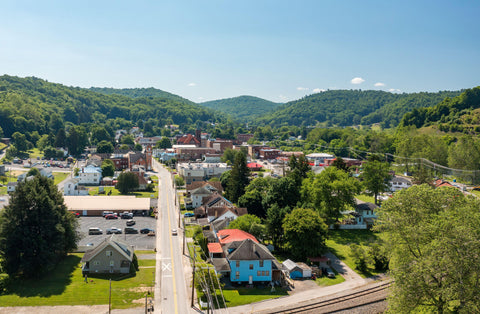
Tread the Ground that Hosted the First Land Battle of the Civil War
Nestled in the mountains of West Virginia, this sleepy historic town erupts with the roar of cannon fire and the steady beat of marching brogans down Main Street every June as it hosts its annual Blue & Gray Reunion. The festivities commemorate the June 3, 1861, battle that broke out here as two columns of Union forces, about 3,000 men, arrived from Grafton under the command of Colonel Ebenezer Dumont and Colonel Benjamin Kelley. A predawn assault was planned to begin on the mark of a pistol shot from the Union command.
Confederate sympathizer Matilda Humphreys, spying the incoming troops from her hillside home, sent her son Newton to warn Confederate troops camped in town. When Union soldiers captured him, she fired a pistol at them. The single shot was mistaken for the battle signal and Union artillery rained fire on the town. The battle had begun.
Inexperienced Confederate volunteers had failed to establish picket lines for security, and many were asleep when the cannons went off. Those who were armed fired shots back, but the Confederate troops quickly fled in retreat. Union journalists dubbed the battle the “Races at Philippi.”
Visit the town every summer for its annual commemoration of the Battle of Philippi, including reenactments, a parade, and living history. Fear not if you can’t make it for the event. Battle artifacts and relics are on display at the town’s history museum, which also houses some unique exhibits related to noted Philippi residents. Civil War Trails signs line Main Street, providing visitors a walking tour of the battle and its aftermath.
GET HISTORY'S GREATEST TALES—RIGHT IN YOUR INBOX
Subscribe to our HistoryNet Now! newsletter for the best of the past, delivered every Monday and Thursday.
Close
Thank you for subscribing!
Submit
Covered bridge, Philippi, W.Va.
Covered Bridge
26426 US-250
Used by both Union and Confederate troops after the Battle of Philippi, the covered bridge was the first to be captured in the war by either side and was used for a time as a barracks by the victorious Union troops. In 1863, the bridge narrowly escaped burning at the time of the Confederate raids on the B&O Railroad west of Cumberland, Md. Orders were issued by Brig. Gen. William E. “Grumble” Jones for the burning of it and of the covered bridge at Rowlesburg, but the intercession of several locals saved both structures.
Blue & Gray Park, Philippi, W.Va.
Blue & Gray Park
US 250/Route 119
A monument here flies five replica flags that flew over Philippi during the Civil War. They include a Confederate regimental flag, the Churchville Cavalry flag, the 34-star United States flag, the Palmetto flag, and Colonel Porterfield’s headquarters flag.
Barbour County Courthouse, Philippi, W.Va.
Barbour County Courthouse
26 N. Main St., Philippi
A church that stood near the site of the courthouse served as a hospital, treating Confederate casualties, including James Hanger of the 14th Virginia Cavalry, whose leg was amputated. Unhappy with his uncomfortable false leg, Hanger patented a prosthetic in 1871 that incorporated a joint at the knee and a hinge at the ankle. He formed Hanger Orthopedics, which made some of the first practical artificial limbs and still produces prosthetics today.
Blue & Gray Reunion, Philippi, W.Va.
Blue & Gray Reunion
On June 3, 1911, Barbour County held its first “Home Coming Week” of the “Blue and Gray Soldiers” who participated in the 1861 battle. The program included speeches, band concerts, “public talks by Old Soldiers,” entertainment, fireworks, parachute jumps, parades, a hot-air balloon ascension, and a “Sham Battle conducted by the State Militia.” In 1988, the City of Philippi published a “Call to Arms” to plan for an annual Blue & Gray Reunion to begin the first week of June 1989. It still runs today and includes a parade, encampments for reenactors from both sides of the war, artillery and small arms demonstrations, a choir concert, Civil War Ball, and living history demonstrations. www.blueandgrayreunion.org
Talbott’s Hill
101 College Hill Rd.
When Colonel Ebenezer Dumont arrived in Philippi during the early morning hours of June 3, 1861, he ordered Colonel James B. Steedman to post two six- pounder cannons here on Talbott’s Hill and then await the signal of a pistol shot to open fire once Kelley’s column was in position. This hillside view of Philippi is located on the campus of today’s Alderson Broaddus University.
Barbour County Historical
Museum, Philippi, W.Va.
Barbour County Historical Museum
13 Museum St.
Housed in the old Philippi B&O Railroad station, this museum showcases the history and culture of Barbour County, W.Va., including its farming and mining history, the Philippi mummies, and Civil War artifacts from the Battle of Philippi and local veterans, including a drum played at Appomattox and the prosthetic leg invented by James E. Hanger, the first amputee of the Civil War. facebook.com/BarbourCountyMuseum
The Chrislip on Main, Philippi,
W.Va.
The Chrislip on Main
167 S. Main St.
With few options in town for lodging, this Airbnb, operated out of a recently restored 1902 home in the heart of downtown, is an ideal overnight option.
